Muskrat Misinformation (vs. the place of Muskrats in the Natural World)
Our WU friend and supporter, Scott Slocum, wrote a fascinating blog about Muskrats. We asked if we could share this conversation about our muskrat furbearer on our WU blog. So here it is. Enjoy! Thank you Scott Slocum!
By Scott Slocum, 12/19/2017. Shared with permission from http://www.ss-slocum.info/home/trapping/blog/muskrat-misinfo_vs_info
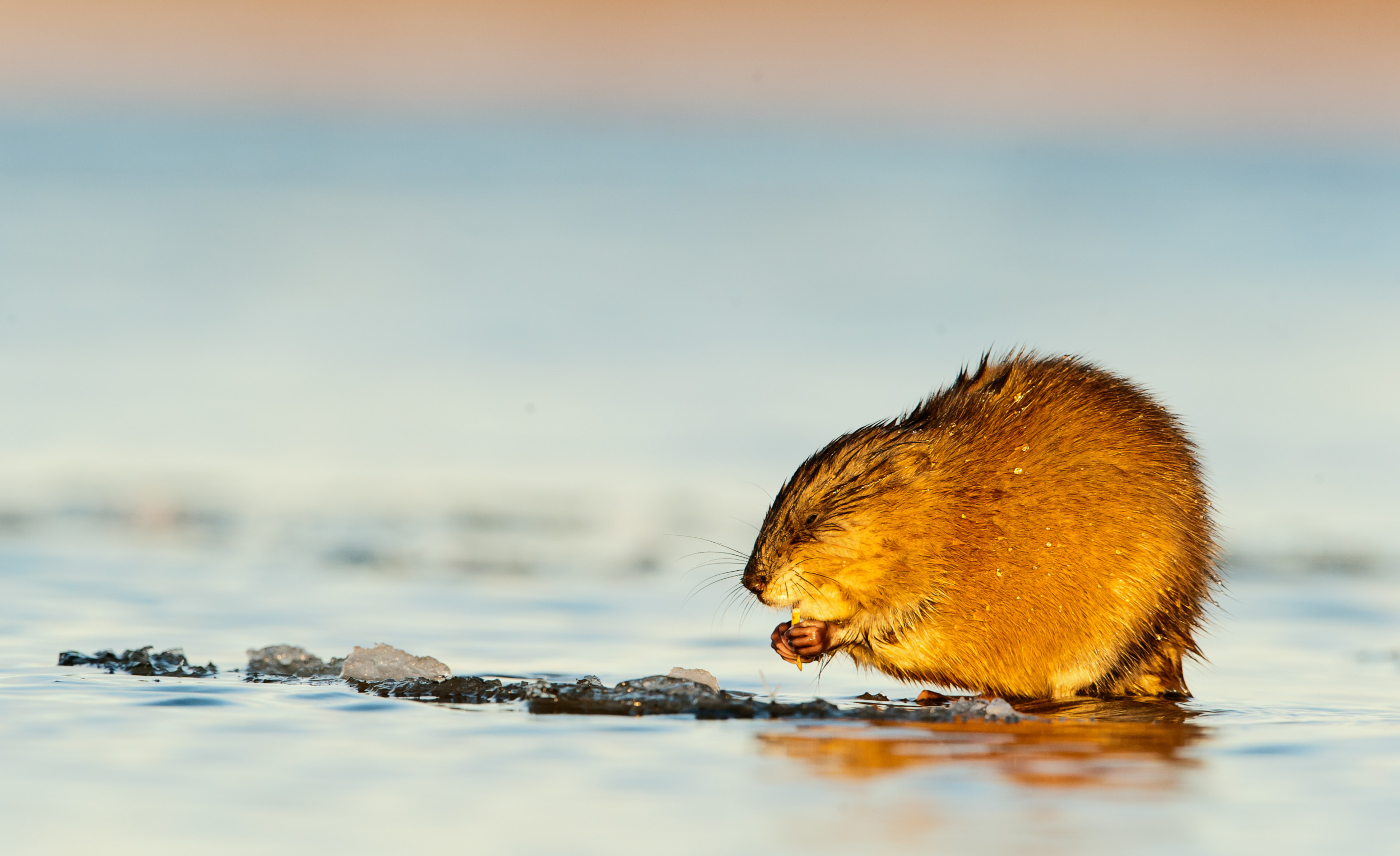
An unfortunate pattern of anecdotal pieces about muskrats appeared in the local news this year: first it was “Little creatures create big problem in local lakes” in the White Bear Press (Bussjaeger 2017), followed shortly by “Influx of Muskrats Creating Problems in White Bear Lake” on KSTP-TV (Mazan 2017). More recently, Google Alerts popped up a notice about “No muskrat love” on SWNewsMedia.com (Jones 2017).
Back in April, I responded to the first of these in my hometown paper with a letter to the editor. I asked readers to look up the word “creature,” and think about what that means (not just how inconvenient the little creatures can be). And I responded briefly to the old trapping myth that “everything would be fine, if more guys were still out trapping.” My response: we can’t just leave everything up to “the guys out trapping.” For our own good, we need to know a little about nature, and take precautions in the outdoors: with tick and insect repellent, vaccinations, clean food and water, and limited contact with wild animals and carcasses. The alternative–trying to rid the natural world of all the things we fear–isn’t simple, reliable, or ethical.
The TV news segment consisted entirely of an interview with a townhome resident who lives near a wetland, and doesn’t like muskrats. Until I heard it, I thought the desire for ridding the world of muskrats, etc. was limited to lakeshore homeowners with their minds set on docks, boats, lawn furniture, and sandy beaches–no muskrats allowed. But it turns out that intolerance can exist even among those who live near marshes. The common denominator seems to be their desire to be left alone, on their decks, with only the animals they like to feed or photograph.
Advice from the extension agency.
An internet search for “muskrat damage” returns a long list of agricultural-extension reports on muskrat control. Most of them seem to be about ponds that are constructed for aquaculture, rice growing, waterfowl production, and/or stormwater management. Even in the internet age, most of the old extension agencies still seem to be repeating the old advice about which traps to use and how to construct the farm ponds to minimize problems with muskrats (e.g. embankment slopes as gradual as 6:1 that are less prone to muskrat tunneling; riprap or wire-mesh protection for the slopes of dams or dikes; water depth sufficient for the purposes of the pond but otherwise deep enough to discourage emergent plant growth; vegetation removed at the end of the growing season; etc.). This can give the false impression that “most experts agree” that these are the only things that a lakeshore homeowner or farm-pond or wetland owner needs to know. But really, it’s just the same, old information, repeated.
Refreshing exceptions include the muskrat-information pages of the University of Kentucky (UKY 2017). Their good advice: “muskrats should be removed only if they are causing problems, because they are a valuable fur resource and an integral part of aquatic ecosystems.” The Wikipedia page on muskrats is good, too (Wikipedia 2017). Other resources include wetland-management guides that discuss the ecological benefits of muskrats in the control of emergent vegetation and the maintenance of open water in wetlands (along with the need for muskrat damage control, e.g. Ducks Unlimited 2005).
These and other resources point out that muskrat populations go up and down naturally, according to factors including weather, water level, food supply, predation, and disease. In other words, although most trappers won’t admit it, trapping isn’t the only factor. The diseases that affect muskrat populations don’t affect humans or pets, as long as common-sense precautions are taken (for ourselves and our pets) with tick and insect repellent, vaccinations, fresh food and water, and the careful handling of carcasses (CDC 2017a CDC 2017b). If we didn’t take these precautions, muskrats would be the least of our worries.
Journalistic imbalance.
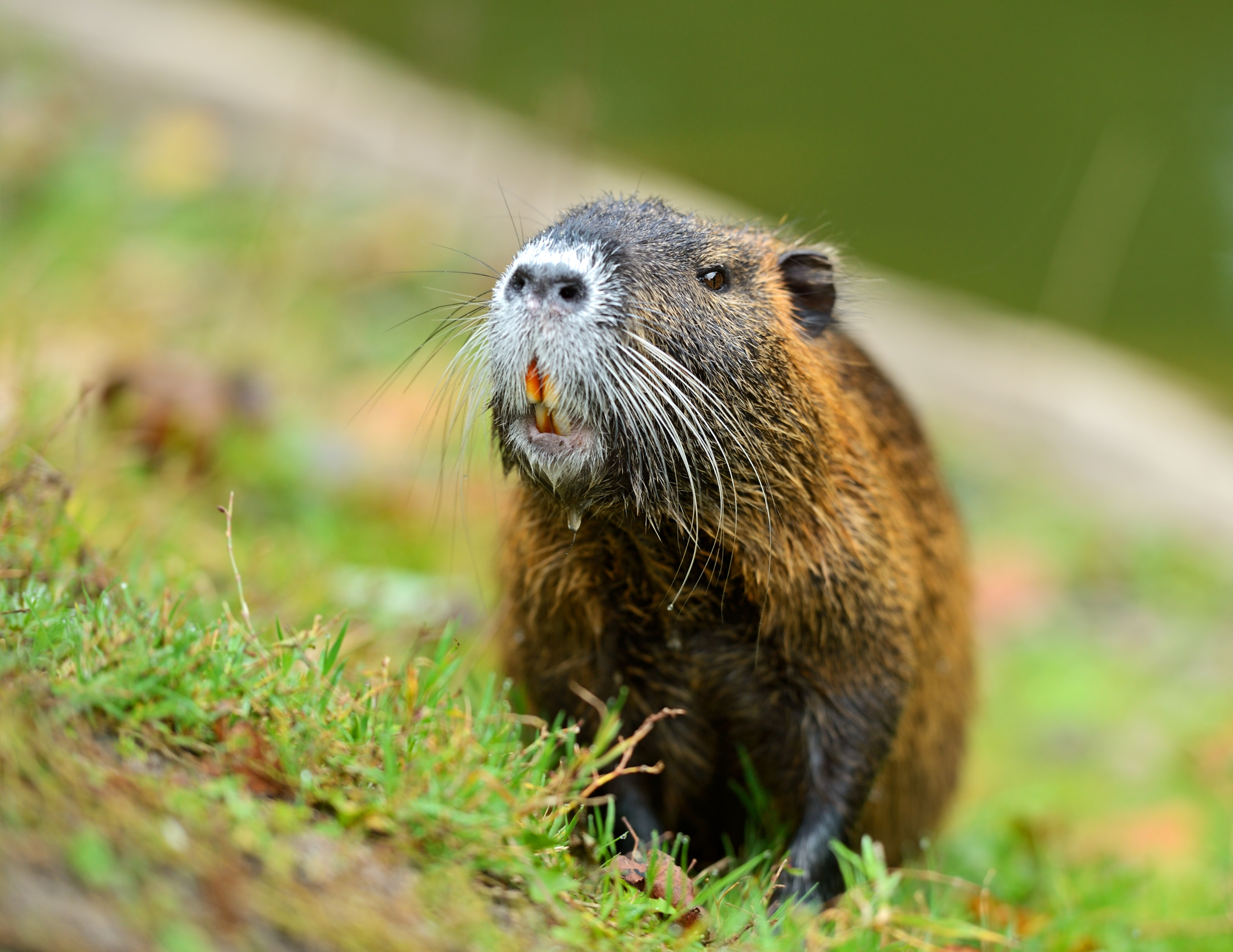
Muskrat on River Bank.
From the looks of the local press coverage on problems with muskrats, there seems to be an excess of lakeshore owners, animal-damage control operators, trapping lobbyists, fish & wildlife officers, and extension agents available to provide questionable material for little pieces in the local news about 1) “the big problems that the little critters can cause”; 2) residents’ concerns for the appearance of their shoreline; 3) how muskrats, “like any other wild animal, need to be controlled”; and/or 4) how “once muskrats are established, trapping is about the only way to get rid of ’em.”
On the other hand, though, there don’t seem to be enough scientists, wetland ecologists, or conservationists available to community reporters with information that could lift these articles above the small concerns and unexamined assumptions of those who “just want the muskrats gone.”
We need to hear more from environmental educators (e.g. Tamarack Nature Center 2017) about the life of a pond: its vegetation, its muskrats, the way the muskrats maintain the open water, and the value of the open water for the other creatures on the pond. And we could hear more from spiritual perspectives; for example, the Anishinaabe creation story of the muskrat’s deep dive for earth (e.g. First Nation Literacy 2011, McGregor 2013, and Pipekeepers 2015). Without this input, our alternative is to trudge along, wondering to ourselves “what use are they?” (where “they” are all of the creatures we fail to understand) and assuming that the answer must be “none.”
No Muskrat Love.
Let’s examine some of the unexamined assumptions in the article in SWNewsMedia.com.
- First, it’s unrealistic to think that sensitive equipment could be left out in a lake, unsupervised, without damage. As if rodents weren’t known for chewing on things that have the consistency of roots, tubers, wiring insulation, rope, rubber, etc. The fact is that they are known for chewing on those things; and the most practical solution isn’t to kill all of the rodents in the area, but just to put the equipment away between uses.
- Second, it’s a poor attempt at humor to suggest that the fecundity of a species could be considered its “biggest claim to glory.” The fecundity of rodents is just one of their adaptive responses to high predation losses, and to the prospects of dispersing to unoccupied territory. Adding to this attempt at humor are the cleverly-reversed headline “No Muskrat Love” (referring to the 1970s song “Muskrat Love”), and the comic-book image of “a bunch of hardened metro super-muskrats evading every snare set in their path.” These are attempts to lighten-up an article that’s really about extermination.
- Contrary to the negative picture of muskrats that’s painted by the article, the reality is that, to well-informed conservationists, muskrats are known for the roles they play as herbivores and prey, and for the many other things they do–between reproductive cycles–that are important to the full functioning of their ecosystems. In fact, muskrats don’t make “claims to glory,” they’re not closely related to beavers, they and beavers aren’t the only creatures in the animal kingdom to build nests in water (e.g. see the caddisfly cases at Hamrsky 2015), they don’t have flat tails, they don’t reproduce at the age of one month, their average litter size in Minnesota is not the maximum of ten, and their average number of litters per year in Minnesota is not the maximum of two or three. Why so many careless references to the natural history of muskrats? Because in order to write about extermination, you need to make the objects seem less interesting (or maybe they’re just not interesting to you).
- Third, variations in the size of muskrat populations on the suburban lakes in the article can’t be solely attributed to fur prices or to the level of interest in fur trapping. Trapping on these lakes is not like what’s traditionally been done on farm ponds and wetlands, in which a sustained, high level of fur trapping has been a controlling factor in muskrat populations (Miller 1975). Ironically, a better indication of the level of trapping on these lakes is hidden within the article itself: according to the statements of almost everyone interviewed, they’re “trying to get rid of muskrats.” That indicates a level of trapping that’s significant, and not a function of fur prices.
- If fur prices were high, the effect of fur trapping on these lakes wouldn’t be what the lakeshore owners expected–because fur trappers don’t “get rid of muskrats.” When they’re making money, fur trappers are making it from sustained harvests, with steady populations of muskrats on the lakes and ponds every year.
- Fourth, the article seems to have borrowed a line from the trapping-lobbyist’s handbook, that “some cities and counties have ordinances against trapping.” That’s partly true; but although there’s at least one suburb in the twin-cities metro area that prohibits the taking of “game,” there’s no way that such an ordinance would or could be enforced as a prohibition against animal damage control.
- By the way, anyone who’s wondering why “trapping kind of gets a bad name” can learn more about it from organizations like “Dog Lovers 4 Safe Trapping MN” (DogLovers 2017) or Wyoming Untrapped (WU 2017)–or by searching the internet for “trap kill dog.”
- Fifth, a large part of the article is focused on the question of whether to relocate or kill the muskrats that are trapped. As if that’s the most important question; and as if, once it’s answered, the question of whether to trap doesn’t even need to be asked. To be fair, hidden within the article (behind another piece of trapping advice), is a partial answer to the question of how to avoid the need to trap, “… if local ordinances permit, by decreasing the slope of the shoreline. Muskrats love a steep bank; gradual slopes are just not as appealing to them.” The reason that this non-lethal solution is hidden, and that other non-lethal solutions aren’t discussed, is that this article is about extermination.
- Sixth, although an effort seems to have been made to end on a more positive note, the information in the final two paragraphs is still cloaked in trapping advice, satire, a qualification, omissions, and an error. If those shortcomings had been addressed, it might have read something like this: “It’s important to remember that the muskrat plays a beneficial role in wetland ecosystems. As herbivores, muskrats help to maintain the open water that’s required by other wildlife. As prey, muskrats are an important food resource for hawks, eagles, owls, and other predators. As lodge-builders, their structures provide nesting platforms for geese and swans. The list of ecological services goes on; and, of course, they’re kind of cute (in a ‘Ratty’ kind of way: Grahame 1908).
Mazan’s interview–almost melodrama.
There’s not much to examine in the TV-news piece (Mazan 2017) except for, maybe, its potential for dramatic development. Mazan might have earned a “best supporting actor” nomination for his jovial narration and humorous cues to the “villain” in the story–except that there was no “hero” to save the day. With a better screenplay, and maybe a rendition of “Muskrat Love” (let’s try it with a ukulele this time, Joe!), Mazan might have taken it all the way to the awards ceremonies.
From anecdote to City Hall.
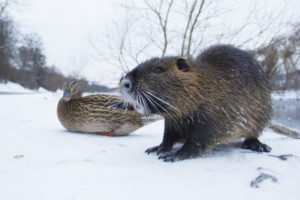 The information that’s been getting to City Hall hasn’t much better than what we’ve been getting in the local news. In the City of White Bear Lake, MN, the trapping lobby has a gripe against the trapping ordinance that was passed in 2013. The ordinance allows for the use of certain traps only in response to a “wildlife-management concern” (WBL 2013). It’s a reasonable ordinance that protects people and their pets from the more dangerous types of traps; but trappers don’t see it that way. They just want to “be out there trapping,” and they figure that pet owners–not trappers–should be in charge of protecting pets (even though they’re the ones who are putting them in danger).
The information that’s been getting to City Hall hasn’t much better than what we’ve been getting in the local news. In the City of White Bear Lake, MN, the trapping lobby has a gripe against the trapping ordinance that was passed in 2013. The ordinance allows for the use of certain traps only in response to a “wildlife-management concern” (WBL 2013). It’s a reasonable ordinance that protects people and their pets from the more dangerous types of traps; but trappers don’t see it that way. They just want to “be out there trapping,” and they figure that pet owners–not trappers–should be in charge of protecting pets (even though they’re the ones who are putting them in danger).
So in 2016, when muskrat populations in the White Bear Lake area cycled back to their multi-year highs, trappers complained that the muskrat population was “exploding… because nobody’s out there trapping… because of the trapping ban.” Of course, their complaint wasn’t based on population surveys, damage estimates, or anything other than seeing more muskrats. And of course, the ordinance isn’t a “trapping ban.” But still, they presented a “wildlife-management concern,” and they got the wheels of government turning.
A careful observer of the shoreline of Birch Lake (in the City of White Bear Lake) from the pedestrian walkway along the north shore can see erosion due to a number of factors, including human paths down to the lake, and depressions where telephone poles have been removed and/or replaced, or where muskrat tunnels have collapsed. Erosion is a special concern on the north shore of the lake, because the road runs so close to it there. In order to keep the roadbed and the lakeshore in good shape, homeowners and the city have installed steps along the paths to minimize erosion, and they’ve refilled and reseeded depressions that were left after utility work or muskrat burrowing. Although it’s been suggested that “muskrats need to be controlled” to avoid damage to the roadbed, the damage hasn’t been quantified; and no estimate has been made of how much damage might be avoided by “keeping the muskrats under control.”
The same observer might be attracted to the two-foot concrete culvert where generations of anglers, birdwatchers, and lake watchers have stood, or sat with their feet dangling in the waves. The culvert connects the lake with its marsh across the road (a wetland that was once continuous, before the road was built). The question of whether or not it was an environmentally sound idea to build the road across the lake here has generally been lost to history, but it can at least remind us that “what we build today, we will need to maintain far into the future,” and that there’s a case to be made for investing in environmental engineering. Again, although there have been suggestions that “muskrats need to be controlled” to avoid blockage of the culvert, there’s been no report of blockage by muskrats, and no explanation of how trapping muskrats might help to keep it clear.
Still, when push came to shove in 2016, a “wildlife management concern” had been expressed, and a call for renewed trapping had been made. The city needed to respond without endangering people or pets on the pedestrian walkway around the lake, and they did so by authorizing the use of cage traps (including colony traps which kill by drowning, but don’t endanger people or their pets).
No other actions were taken to reduce roadbed erosion. If the allowance for trapping was considered a political victory by some, it was an empty one; because the trapping ordinance had always allowed cage trapping, even on public lands and waters, and even without establishing a “wildlife management concern.”
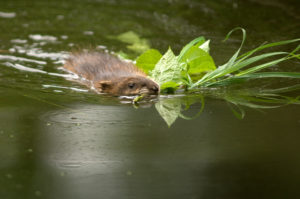
Muskrat swimming back to den with food. By Tony Campbell
How we can do better.
Muskrats are creatures, like us, living in a complex, natural world. Their lives have purpose, but unless we pay attention to it, we’re likely to think that it boils down to how “cute” we think they are, or how inconvenient we find them to our plans for the lakeshore.
What can we–as suburban lakeshore owners and wetland shore owners–do differently to improve on the poor advice we’re getting from the local news?
To start with, we can acknowledge that, although we have title to the land and public rights to the water, we don’t own nature. We’re a part of nature, and we can learn to be a better part. We can learn, for example, that if we leave chewable products out in the lake at night, they’re likely to be chewed-up by morning. We can learn that, if we live near a marsh, we’re likely to see muskrats crossing our lawns and streets in the Spring, even if some see that as a cause for extermination.
Next–given that we’ve built-over the wild ecosystems that formerly existed along our wetlands; and given that we’ve upset the balance of predator and prey, of wild herbs and herbivores, and of all the creatures that we’ve forgotten were even a part of the plant, animal, and other living kingdoms–we can take the good advice of our more knowledgeable extension agents (e.g. UKY 2017) and improve our efforts to 1) design and build structures that resist destruction by natural forces; 2) trap rodents when necessary, without killing our neighbors’ pets, or maiming wild predators and scavengers–all of which are attracted, sometimes from long distances, to the baits and lures of traps; and 3) kill the trapped rodents as necessary–but in a business-like fashion, without pretending that we have “no other choice.”
It wouldn’t be that much of a change; maybe for a new generation that could get past our limitations. A generation with more of the environmental learning that we didn’t have in our biology textbooks, the environmental engineering that we didn’t have in our industrial training, and the traditional reverence and respect for nature that we didn’t have in our stories. They could do it, and we could get them started.
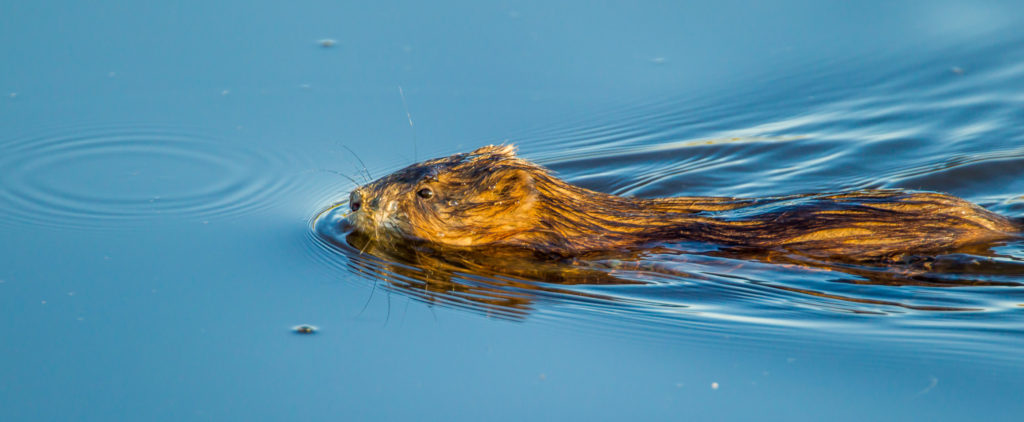
Muskrat swimming in water.
References
Bussjaeger, Jackie. 2017. “Little Creatures Create Big Problem in Local Lakes.” Press Publications, April 5, 2017.
http://www.presspubs.com/white_bear/news/article_5a47bebe-1a10-11e7-a7ba-efc9eca90397.html
CDC. 2017. “Tularemia.” Centers for Disease Control and Prevention. 2017.
https://www.cdc.gov/tularemia/index.html
CDC. 2017. “Viral Hemorrhagic Fevers (VHFs).” Centers for Disease Control and Prevention. 2017.
https://www.cdc.gov/vhf/virus-families/index.html
Dog Lovers 4 Safe Trapping MN. 2017.
http://www.doglovers4safetrappingmn.org
Ducks Unlimited. 2005. “Wetland Habitat Management: A Guide for Landowners.”
http://www.ducks.org/media/Conservation/GLARO/_documents/_library/_landowner/Landowner_Guide.pdf
First Nation Literacy. 2011. “The Ojibway Creation Story.” Illustrated video with a reading of the story.
https://youtu.be/Etn92Ms8plo
Grahame, Kenneth. 1908. The Wind in the Willows. England: Methuen.
One nice animation: https://youtu.be/TvsUCkRGdTk
Hamrksy, Jan. 2015. “Caddisfly Larvae (Order Trichoptera).” Freshwater Life. June 27, 2015.
http://lifeinfreshwater.net/caddisfly-larvae-trichoptera/
Jones, Hannah. 2017. “No Muskrat Love.” Jordan Independent, December 9, 2017.
http://www.swnewsmedia.com/jordan_independent/news/no-muskrat-love/article_f06279a9-9a04-583e-b8fe-4f1196131b11.html
Mazan, Joe. 2017. “Influx of Muskrats Creating Problems in White Bear Lake.” KSTP-TV 5 Eyewitness News. White Bear Lake, MN, USA: ABC.
http://kstp.com/news/white-bear-lake-residents-muskrat-influx-minnesota-department-of-natural-resources/4450676/
McGregor, Deborah. 2013. “Teachings from the Muskrat.” Muskrat Magazine, March 4, 2013.
http://muskratmagazine.com/teachings-from-the-muskrat
Miller, James E. 1975. “Muskrat Damage Control.” In Great Plains Wildlife Damage Control Workshop Proceedings. Vol. 199.
http://digitalcommons.unl.edu/gpwdcwp/199
Pipekeepers. 2015. “The Creation Story–Turtle Island.” Author unknown.
https://www.pipekeepers.org/uploads/3/1/3/0/31306445/the_creation_story.pdf
Tamarack Nature Center, Ramsey County Parks & Recreation. 2017. Field Trips, including “Wetland Wonders,” “Go with the Flow,” and “Aquatics, Inc.”
https://www.ramseycounty.us/residents/parks-recreation/tamarack-nature-center/programs-events/group-programs/third-%E2%80%93-fifth-grade-field-trips
University of Kentucky. 2017. “Muskrat Facts and Biology.” College of Agriculture, Extension, Department of Forestry and Natural Resources. 2017.
https://forestry.ca.uky.edu/muskrat_damage
White Bear Lake, MN. 2013. City Trapping Ordinance, Section 702.044.
https://www.whitebearlake.org/sites/default/files/fileattachments/administration/page/1721/chapter_702.pdf
Wikipedia. 2017. “Muskrat.”
https://en.wikipedia.org/wiki/Muskrat
Wyoming Untrapped. 2017.
https://wyominguntrapped.org
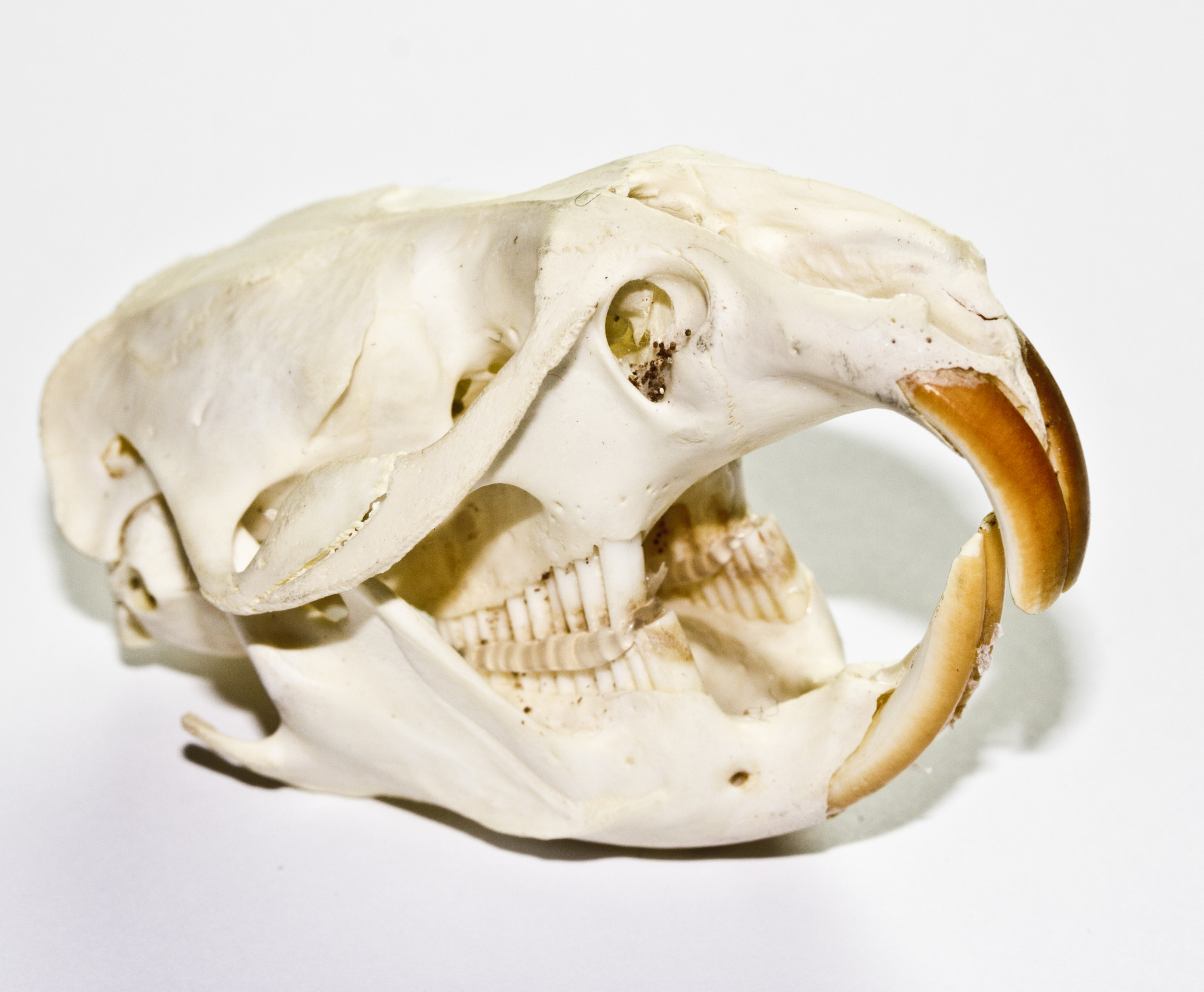
Muskrat Skull



Scott Slocum
Thanks for sharing!
Wyoming Untrapped
Scott, We are honored to share your research and thoughts. Muskrats are an undervalued furbearer, but your article has clarified their role on our public lands. Thank you!